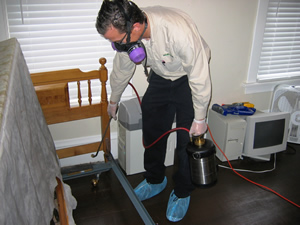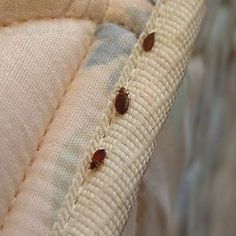Exploring the Scientific Research Behind Bed Bug Warmth Treatments as a Sustainable Pest Administration Strategy
In the world of pest administration, the pursuit for efficient and sustainable options continues to be a continuous search. One such technique that has actually acquired traction recently is making use of warmth treatments to deal with bed bug invasions. By using the science behind thermal fatality points for these relentless insects, warm therapies offer an appealing alternative to standard chemical-based strategies. The complexities of exactly how warmth effectively eliminates bed insects and the more comprehensive effects for lasting pest monitoring techniques make this a topic worth exploring additionally.
Bed Insect Warm Treatment Refine

Thermal Fatality Point for Bed Pests
Subjecting bed pests to raised temperature levels beyond their thermal resistance range is critical for attaining effective obliteration in warm therapy procedures. The thermal fatality factor for bed insects describes the temperature at which these bugs can not survive. Research study shows that bed pests start to perish when subjected to temperature levels above 113 ° F(45 ° C) for a sustained duration. As the temperature raises, so does the mortality price of bed pests. At around 118 ° F(48 ° C ), bed bugs start to pass away swiftly, with a mortality price of nearly 99% within mins of direct exposure. This shows the sensitivity of bed insects to heats and highlights the efficiency of warm therapies in eliminating infestations. By reaching and maintaining temperatures over the thermal fatality factor for bed insects, parasite monitoring professionals can make sure thorough elimination of bed pest populaces, consisting of hard-to-reach areas where chemical treatments might be much less efficient. Understanding the thermal death factor for bed bugs is necessary for carrying out successful warmth treatment techniques and attaining lasting bug monitoring results.
Benefits of Heat Treatments
Having established the vital thermal death point for bed bugs, it is critical to currently check out the considerable advantages that heat therapies provide in properly getting rid of these resistant bugs. One of the main benefits is that warmth can penetrate deep right into cracks and holes where bed insects conceal, ensuring that also the most hard-to-reach locations are heated up to dangerous temperature levels.
Furthermore, heat treatments are ecologically friendly and non-toxic, making them a lasting parasite administration strategy. Unlike chemical pesticides, heat therapies do not leave hazardous residues that can pose dangers to human health or the atmosphere. This element is specifically essential in sensitive environments such as medical facilities, institutions, and houses where chemical use might not be preferable.
Additionally, heat therapies have a high success rate in eliminating bed insect problems in a single treatment, reducing the requirement for multiple check outs and lessening disruption to occupants. This efficiency not just conserves money and time but likewise supplies comfort to those taking care of bed pest issues.
Effectiveness of Warm Treatment

Warm treatments have the added advantage of killing bed bug eggs, which are often immune to traditional chemical treatments. Generally, the performance of heat therapies in eradicating bed insect invasions makes them a trusted and sustainable insect monitoring approach.
Lasting Insect Monitoring Advantages
Implementing lasting parasite monitoring methods uses lasting benefits for both the setting and public wellness. By making use of techniques such as warm therapies for bug control, we can lower the reliance on hazardous chemical pesticides that can have unfavorable results on ecosystems and human health and wellness - bed bug heat treatment. Lasting insect monitoring techniques help in preserving biodiversity by targeting particular pests without harming non-target organisms, therefore maintaining a balanced community
Moreover, sustainable parasite monitoring practices add to the overall health and wellness and well-being of the public. By decreasing exposure to poisonous chemicals utilized in typical parasite control approaches, heat treatments supply a more secure alternative for insect administration in residential, commercial, and public spaces. This reduction in chemical usage likewise helps in avoiding chemical deposits from polluting soil, air, and water, safeguarding environmental top quality.
Final Thought
Finally, bed pest warm therapies have been shown to be a efficient and lasting parasite monitoring method. The thermal fatality point for bed bugs makes them prone to warmth treatments, which have various benefits over typical chemical therapies. The effectiveness of warm therapies in removing bed bug infestations while decreasing ecological effect highlights the possibility of this method as a sustainable solution for insect control.
The bed pest heat treatment procedure entails increasing the temperature within infested locations to a degree that properly eliminates bed insects and their eggs. By getting to and keeping temperature levels above the thermal fatality factor for bed pests, pest monitoring specialists can make certain extensive elimination of bed insect populations, including hard-to-reach areas where chemical therapies may be less reliable. One of the key benefits is that heat can permeate deep into crevices and fractures where bed bugs conceal, guaranteeing bed bug treatment that even the most hard-to-reach locations are warmed to lethal temperatures. Unlike chemical treatments that may leave behind immune populaces, warmth therapies provide a ecologically friendly and non-toxic solution that can permeate deep right into furnishings, walls, and other hard-to-reach locations where bed bugs conceal.
The thermal death point for bed bugs makes them vulnerable to heat treatments, which have countless advantages over standard chemical therapies.